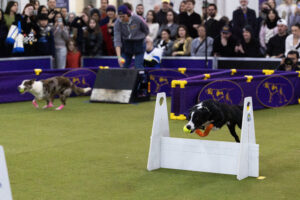Flyball 101
BY JESSICA BRAATZ
Red. Yellow. Green. Buzz! The first dog springs into action, and the cacophony begins. Fans cheer and dogs bark excitedly while their handlers yell commands and praise over the crowd. I watched in awe as these incredible dogs balanced grace and electric speed, bounding over hurdles and sprinting to their teammates. This is flyball, and it sure entered Westminster with a bang.
Though new to the Westminster Kennel Club Dog Show, flyball has a history dating back to the late 1960s and early 1970s. The sport took shape with the creation of the first “flyball box,” evolving from a human thrower, and quickly gained momentum, leading to the first ever flyball tournament in 1983. The following year, the North American Flyball Association was formed by 12 regional clubs, and the sport has grown rapidly since. Today, more than 400 active clubs and 6,500 competing dogs participate across the country. With this nationwide growth, the dynamic, action-packed sport made an overwhelmingly successful debut at Westminster in 2025.
 Despite its nationwide popularity, Flyball remains a mystery to many of us in the dog world, making its Westminster debut all the more exciting. As a conformation exhibitor myself, flyball had always felt elusive, so when I saw it on the schedule, I knew I had to see it in action. To my delight, I arrived just as Westminster President Dr. Donald Sturz was preparing to release a Border Collie down the course. The energy was palpable, and he, like me, was determined to be fully immersed in this action-packed event.
Despite its nationwide popularity, Flyball remains a mystery to many of us in the dog world, making its Westminster debut all the more exciting. As a conformation exhibitor myself, flyball had always felt elusive, so when I saw it on the schedule, I knew I had to see it in action. To my delight, I arrived just as Westminster President Dr. Donald Sturz was preparing to release a Border Collie down the course. The energy was palpable, and he, like me, was determined to be fully immersed in this action-packed event.
Amid the action, there are precise rules and structures in place to ensure safe and fair competitions. If you are unfamiliar with the mechanics of flyball, it is a tournament-style competition resembling a relay race. Each team is comprised of four actively running dogs and four handlers. Teams also often have one to two backup dogs and handlers, along with a box loader and one or two runners who pick up loose balls. Each team must supply its own box and regulation balls—these balls may be any color, but they must roll and bounce if dropped on a solid surface. The actual tournament is divided into divisions by speed rather than dog size, and the entire team’s jump height is determined by the shortest dog running. Teams can include dogs of any breed, including mixed breeds, as long as each competitor is at least 15 months old. This can make for quite a collection of dogs on the course at one time.
During the competition, each dog takes a turn running the 51-foot course, over four hurdles each spaced ten feet apart, and onto the spring-loaded flyball box. The dog then retrieves a ball from the box, pivots, and completes the course the other direction, returning to their handler with the ball. All the while, a dog on the opposing course is racing, a ball loader is reloading the flyball box, and a teammate is readying the next dog to be released. The ultimate goal is to win points by completing the course as quickly as possible with no errors. This requires a team effort from all dogs and their human counterparts, as each dog must be released at precisely the correct moment to pass noses with the returning dog just as they cross the finish line. All the while, an apparent stoplight directs the teams, and a judge oversees the competition. The teams compete until one group wins three out of the five total heats.
 Despite a basic run-down of the rules, I was wholly unprepared for what would happen once the light turned green, the buzzer sounded, and the first two dogs went flying. It was organized chaos. Dogs sped by so quickly I could barely comprehend what was happening. Lights flashed yellow to green, handlers cheered for their dogs, and balls rolled everywhere. Spectators stood on their toes, barely containing their own awe at the canine exuberance we were witnessing. Handlers draped soft braided toys around their necks with massive furry tugs on one end. They held them out in anticipation as each dog completed their run and launched onto the toy, a game of epic tug-of-war signaling the completion of a run.
Despite a basic run-down of the rules, I was wholly unprepared for what would happen once the light turned green, the buzzer sounded, and the first two dogs went flying. It was organized chaos. Dogs sped by so quickly I could barely comprehend what was happening. Lights flashed yellow to green, handlers cheered for their dogs, and balls rolled everywhere. Spectators stood on their toes, barely containing their own awe at the canine exuberance we were witnessing. Handlers draped soft braided toys around their necks with massive furry tugs on one end. They held them out in anticipation as each dog completed their run and launched onto the toy, a game of epic tug-of-war signaling the completion of a run.
The flyball teams brought not only excitement to the floor, but they also brought a sense of personality and fun with their often pun-themed team names. This year, Party Barkers – Sorry for Party Barking brought home first place in the Regular Division with a best time of 16.913 seconds. The Multi-Breed Division One winner was Manic Menagerie – We’re All Mad Here, and the Division Two winner was Ready, Set, Ruckus! – Don’t Push Your Ruckus. Each team consisted of diverse breeds and mixes of all different sizes, from Border Collies to Pyrenean Shepherds to Golden Retrievers.
 Beyond each dog’s speed, I was fascinated by the condition each of the competitors was in. These courses require fast-paced and extraordinary performances, and the dogs that compete are true athletes of the highest degree. Their muscling was incredible, and each handler was also extremely knowledgeable and attentive to their individual animal’s needs. Some handlers even vet-wrapped their dog’s feet or pasterns to protect dewclaws, carpal pads, and toes from the impact and potential burn of their quick turns and pushes. At the end of the day, it was clear that despite the pressure and excitement of competing at the inaugural event, the dog’s needs and care ranked above all.
Beyond each dog’s speed, I was fascinated by the condition each of the competitors was in. These courses require fast-paced and extraordinary performances, and the dogs that compete are true athletes of the highest degree. Their muscling was incredible, and each handler was also extremely knowledgeable and attentive to their individual animal’s needs. Some handlers even vet-wrapped their dog’s feet or pasterns to protect dewclaws, carpal pads, and toes from the impact and potential burn of their quick turns and pushes. At the end of the day, it was clear that despite the pressure and excitement of competing at the inaugural event, the dog’s needs and care ranked above all.
Throughout my time spectating, I realized I was witnessing something truly special. Flyball stands apart from other dog sports in one key way: it is a genuine team sport. In most dog competitions, the team is a partnership between dog and handler, but flyball goes further. With at least four handlers running per team, plus the rest of their support system, the sport fosters a remarkable level of camaraderie. There were familial-like bonds between the competitors of each team, as well. They celebrated their dogs together, win or lose, and enjoyed the glory of the moment of being at an inaugural Westminster event. That contagious joy stayed with me as I walked back to the Agility side and reflected on the lasting impression the sport had made. It was a feeling of pure joy and electricity, celebrating the skill, drive, and talent of these canine companions.
Flyball will return to the Westminster Kennel Club Dog Show in 2026, bringing its fast-paced, thrilling competition back to the national stage. For those who have never witnessed the speed, precision, and teamwork required to compete at this event, Westminster offers a rare glimpse of these canine teams in action. For fans and newcomers alike, flyball is an unmissable addition to an already action-packed week of canine celebration. To learn more about the game of flyball, visit our Learn Flyball page.

